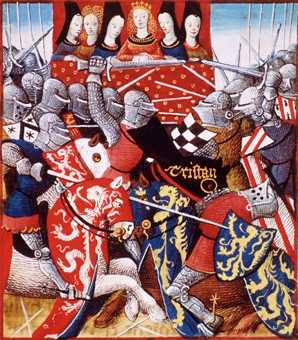Tournaments and Jousting

This 15th-century illuminated manuscript page
from the Romance of
Tristan shows ladies watching knights
participate in tournament.
![]()
The
Tournament
![]()

This 15th-century illuminated manuscript page
from the Romance of
Tristan shows ladies watching knights
participate in tournament.
![]()
The
Tournament
![]()
Over 800 years ago, knights began to fight mock combats for sport known as tournaments. Knights, as individuals or groups, engaged one another in combat, and by using a lance, tried to knock his opponent off a horse. These tournaments gave knights a chance to hone their battle skills, as well as show off their fighting skills. The first contests were rough melees and contained very little chivalry. Knights ganged up on other knights and prisoners were taken. Losing knights were forced to give up their horses and armour, or pay a ransom. As the idea of chivalry spread, tournaments became more and more popular. Blunted weapons slowly began to be used and the combat area, or list grew smaller, making it easier to judge. Although blunted weapons were introduced, injuries and death were still common.
The tournament was usually held on the invitation of a prince. The tournament was a colorful pageant, with the prospective combatants hanging their shields on the trees, tents, and pavilions around the arena for inspection to show they were worthy, by their noble birth, their faultless character, and their military skillfulness, of the honour of contending. A tree of chivalry, either real or artificial, was symbolic and used in many tournaments. The tree was either hung with the shields of participants, or colored shields representing the forms of combat, such as joust, tourney, or foot combat, were hung instead of the shields. Those accepting the challenge, the "answerers", or their heralds, toughed the appropriate shield to select the form of combat. Rules determined the number of blows allowed. The lists measured from 100 by 80 yards up to 300 by 100 yards, or sic times the area of a football field.
Grandstands were set on the grounds for nobles, ladies and judges. These stands were decorated with banners and coats of arms. Kings and nobles who originally thought of tournaments as an unsafe assemblage of fighting men, showed off by hosting elaborate events. While watching the tournaments, sometimes the spectators became so excited, violence would break out. This led to spectators being searched for concealed weapons before the tournament.
The
ladies of the court dressed in their finest clothes and looked on admiringly.
A knight would declare himself a lady's champion by tying her scarf on
his sleeve, hoping to win her favour.
![]()
![]()